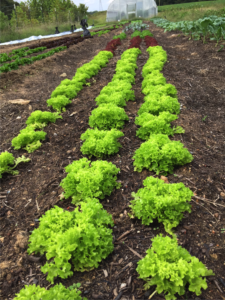-Chris Amaya-

Growing a productive fall vegetable garden takes thoughtful planning and good cultural practices. Although August is the main planting time for fall gardens, season extension practices can give you the flexibility of starting late. Garden cloches made from bottles or hoop house structures can greatly increase productivity for the avid gardener. Seeding of shorter-season vegetables, such as turnips and leafy greens, can be delayed until September 1 in the NC piedmont. Keep in mind that the planting dates can be as much as 10 to 20 days earlier in western North Carolina and 7 to 14 days later in the NC coastal plain. Be sure to adjust the planting dates for a specific location by noting the frost date and counting backward on the calendar the days to maturity of the vegetables.
Before preparing the soil for a fall garden, it is best to remove the remains of the spring/summer garden to ensure decaying material goes in the composter where pathogens can be burned away, rather than staying in your planting beds. Mold spores and some diseases can take years to break down, which is why some farms have trouble season after season harboring the same pathogen. This process can be corrected by planting fall cover crops (A.K.A. green manure crops) that keep beneficial bacteria alive to outcompete the bad ones.
Green manure crops—such as winter rye, hairy vetch, Austrian winter peas, ryegrass, or tillage radish—can be planted in the fall and tilled under in the spring when growth is about knee-high. For best results, seed fall cover crops before October 20th in the NC piedmont (one to two weeks later in the NC coastal plain, and one to two weeks earlier in the NC mountains). Cover crops are not limited to fall planting, however, so the possibilities of keeping your soil alive is endless.

Clover or buckwheat can be planted after harvesting early spring vegetables like lettuce or spinach and turned under in time to plant a frost-tolerant crop in the late summer. Personally I use buckwheat as a “filler crop” in my garden if I am unsure what to plant next because it only takes 30 days to mature and provides plenty of organic matter to give back to the soil. Clovers create a nice blanket of growth that retains heat and allows soil to continue to thrive.
Nitrogen fixing crops —many microorganisms fix nitrogen but these legumes can greatly increase the productivity of other plants by “fertilizing” the soil when they die. My favorites to incorporate in my fall planning are clovers, alfalfa, peanut, and vetch because they give back a lot of organic matter for the buck. These plants pull the element out of the atmosphere that builds up as gas in the root nodule formation and is released when the plant is killed. These nodules come in different shapes and sizes that are distinctly visible depending on which plant makes them. For instance, soybeans create a spherical shape while clovers produce a club-shape. Nodules can form on stems and leaves but are mostly found on root systems. Mature nodules are identifiable by their pink and reddish internal color while young nodules are generally white or grey inside. Larger nodules indicate high efficiency of fixation, but most are about 0.5cm in diameter.
Fall is also a great time to plant new trees and bushes that also fix nitrogen (non legumes) such as Cherry Silverberry, Redbud, Black Locust, and Mimosa. These trees and shrubs may be bigger but they are not as efficient nitrogen fixers because it takes longer for them to die and release the element.

Vegetables that can be grown in the fall garden include beets, beans, broccoli, Brussels sprouts, cabbage, cauliflower, carrots, collards, kale, kohlrabi, leaf lettuce, mustard, radishes, rutabagas, spinach, turnips, and southern and sweet peas. Seeds should be planted deeper in the fall because the moisture level is lower in the soil, and the soil surface temperatures are higher. In many cases, the planting depth may be 1½ to 2 times as deep as for spring planting of the same crop. The seeded area may need to be covered with vermiculite, burlap, newspaper, or boards to keep the soil cool and moist, but be sure to remove covers as the seeds begin to germinate.
Direct seeding is often used in the fall for crops such as broccoli and collards. The success of this planting method, however, depends on having enough moisture available to keep the young seedlings actively growing after germination so using a cold frame is key. If there is no irrigation source, buy vegetable transplants from a local garden center instead of seeding. Most fall vegetables benefit from an application of nitrogen three and six weeks after planting.
Whether you’re cultivating a fall garden actively, or putting in cover crops to enrich your garden for spring, we’ve got the supplies, equipment, and knowledge to help you be successful!

Leave a Reply